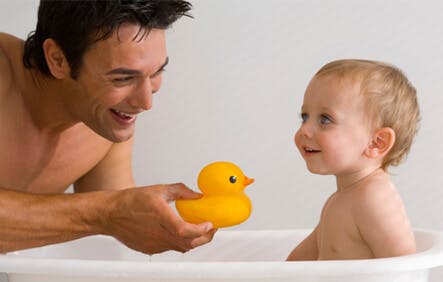Cleaning the Penis with Intact Foreskin

Question
My 19 month-old son was not circumcised at birth at my husband's request. I am the one that gives him his bath, and mostly change his diapers every day but I never do anything specific to clean his penis. I've heard that I'm supposed to but have no idea what to do, and my husband tells me not to do anything specific. I just want to make sure I'm doing the right thing. Do you have any recommendations?
Texas
Dr. Greene`s Answer:
Today in the office, a great mom asked me about her son’s newly acquired habit of licking garden snails. Little boys often have a very different sense of hygiene than their mothers. They delight to splash in muddy water, and think nothing of the trail of mucus running down the nose that prompts many mothers to action. Most little boys will not spontaneously wash their hands or clean their penises. So what to do with a foreskin?
If this conflict weren’t enough, sources of childcare information have very different recommendations for care of uncircumcised penises. Some advocate aggressive wiping using cotton swabs and alcohol to clean under the foreskin. At the other extreme, some authorities suggest doing nothing at all until puberty, saying that the collection of cheesy material under the foreskin is natural and desirable. One popular childcare book even differs from itself, saying in a caption, “The uncircumcised penis requires meticulous hygiene; the circumcised penis … requires no special care,” while the accompanying text says, “Contrary to what was once believed, no special care is needed for the uncircumcised penis.”
I recommend a more moderate approach.
Structurally, the penis consists of two main parts, the shaft and the head (which is called the glans). Urine and semen exit the body through a tiny opening at the tip of the glans. At birth, the shaft and the glans are covered by a single continuous layer of skin. If circumcision is performed, the part of this skin that covers the glans is cut off. Immediately after circumcision the glans appears swollen, tender, and vivid red, since the foreskin was firmly attached to the glans before it was forcibly separated and then cut off.
In uncircumcised boys, the foreskin at first remains firmly attached to the glans, but gradually over time the attachments are broken (mostly by the stretching resulting from repeated normal erections). In 90% of boys the foreskin is loose and mobile by age 2, but the process can sometimes take five or more years. When the foreskin has separated from the glans, the foreskin can easily be retracted, or pulled back, to leave the glans exposed. Throughout life, a cheesy white material called smegma, consisting primarily of dead skin cells and secretions from sebaceous glands, will accumulate underneath it.
In uncircumcised boys, forcibly ripping the foreskin from the glans in the name of hygiene can lead to pain, scarring and adhesions. Do not try to forcibly retract the foreskin or to clean under an adherent foreskin with swabs, antiseptics, or even water. On the other hand, even though doing nothing at all may be considered natural, similar reasoning would lead to not cutting the hair, trimming the nails, washing the hands, or cleaning the bottom after a poop. Gentle hygiene enhances health.
Only the outside of the foreskin needs to be cleaned during the first year. It should be cleaned and bathed with soap and water just like the rest of the diaper area. After his first birthday, you might want to very gently pull back on the skin of the shaft to see if the foreskin retracts. If it doesn’t at all, don’t worry — and don’t force it! There is certainly no rush. If urine can flow freely, the hole in the foreskin is big enough. As long as the foreskin doesn’t easily retract (even in a ten year old), only the outside needs to be washed. If the foreskin retracts a little, it would be okay to gently clean the exposed part of the glans with water (but don’t use soap while the foreskin is still partially attached to the glans, since this can irritate this tender area). After cleaning, always pull the foreskin forward to its usual position. This is very important — otherwise it can get stuck and lead to serious damage.
Once the foreskin has completely separated and retracts freely, begin to teach your son to retract his own and clean underneath it when he bathes, or at least once a week. For most little boys this personal cleaning will not become a habit unless you encourage it. Mentioning it positively and frequently throughout the years can instill an important sense of responsibility, prevention, and health that will benefit him for years to come.
Your bathtimes together are precious now, but the habits you help your son develop might also reduce sexually transmitted diseases and cancer of the penis (and cervix in his partner) when your little boy becomes a man.


